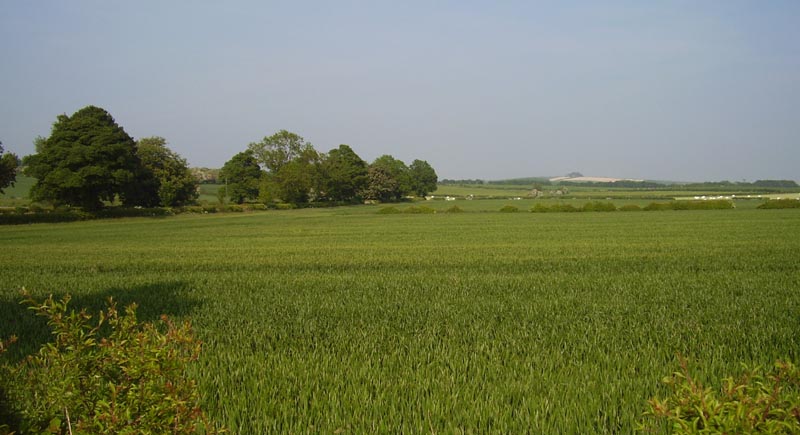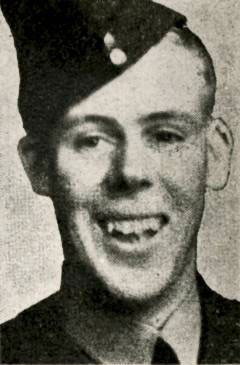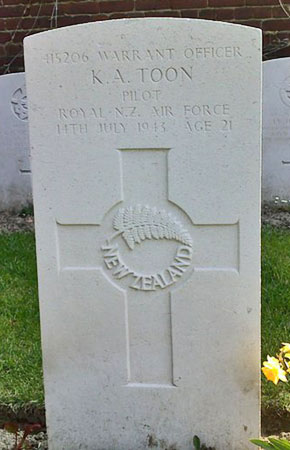Halifax W7939 near North Grimston.
During the evening of 29th March 1943 a number of 78 Squadron aircraft took off from Linton on Ouse for Ops to Berlin. In total 329 aircraft took off for the raid to Berlin on this night. This specific aircraft set out at 21.36hrs and climbed to 8000 feet when the oil pressure dropped in the port inner engine. This led to the engine's big end failing and soon afterwards the crank shaft breaking. This in turn led to complete loss of the aircraft's oil. The bomb load was jettisoned at 22.00hrs over a currently unknown location and the crew baled out at a safe height but with low cloud in the area the pilot opted not to try and land the aircraft. He baled out when the failed engine caught fire and the aircraft crashed between North Grimston and Langton at 22.15hrs. The investigation stated that the pilot should have attempted to feather the damaged engine earlier in the sequence despite him being relatively inexperienced on the Halifax with only 31 hours flying the Halifax at night.
Pilot - Sgt Kenneth Alan Toon RNZAF (NZ.415206).
Flight Engineer - Sgt Lawrence George Donaldson RAFVR (1280330).
Navigator - Sgt Royston Falcus RAFVR (1479674).
Bomb Aimer - Sgt Harold James Burridge RAFVR (1379810).
Wireless Operator / Air Gunner - Sgt John Patrick Whelan RAAF (403883). Injured.
Air Gunner - Sgt George Morven Campbell RAFVR (1071995). Injured.
Air Gunner - P/O Jack Richard Sands RAFVR (172710).
Halifax W7939 was built to contract B.73328/40 by Handley Page Ltd, at Radlett. On 13th December 1942 the aircraft was taken on charge by 78 Squadron at Linton on Ouse. As a result of the crash on 29th March 1943 Cat.E2/FA Burnt damage was the damage assessment. The aircraft was struck off charge some days later on 11th April 1943 having recorded just over 165 hours total flying time up to it's destruction. A map reference for the crash site sourced from the Yorkshire Air Museum plots to the area shown on the above photograph but whether this is where it actually came down is not yet known, I have not yet been able to locate the landowner to ask permission to field walk it.
Kenneth Toon (picture above) embarked New Zealand for the UK in April 1942, on 30th June 1942 he begun training with 2(P)AFU and on 15th July 1942 began training with 6(P)AFU but was "slightly injured on active service" on 29th August 1942. He was posted to 15 OTU on 8th September 1942 and later to 1652 HCU on 20th January 1943. Towards the end of Fenruary 1943 he was posted to 78 Squadron. He flew his first operational flight as a second "dickie" pilot on 5th March 1943 with Sgt Riach to Essen and then flew a second as second pilot on 9th March 1943 to Munich. On the 11th March 43 he flew his first operational flight as captain (with Sgt Whelan as his wireless operator) to Stuttgart. On 26th March 1943 they flew to Duisburg and on 27th March 1943 to Berlin. The incident at North Grimston occurred on 29th March 1943 with Sgt Whelan sustaining injuries following his descent.
On 14th July 1943, the now Warrant Officer Toon was the pilot of Halifax JD108 when it was shot down by a night-fighter over Belgium. Of those named above involved in the incident near North Grimston Toon and Burridge were killed, Sgt's Donaldson and Falcus evaded capture, and Sgt Campbell became a PoW. W/O Toon was twenty one years old; he and Burridge are buried in Gosselies Communal Cemetery, Belgium. The photograph of W/O Toon's grave was found on Facebook. Kenneth Toon was married by the time he arrived in the UK, his wife Margaret lived at Osgoode Station, in Ontario, Canada.
As previously stated both Donaldson and Falcus evaded capture and returned to the UK. Lawrence Donaldson was born on 23rd May 1915. He found the famous Comete escape line and made it back to the UK through them. Royston Falcus evaded capture but his route home is not yet known. He was later commissioned on 24th September 1944 to the rank of P/O on probation (emergency) and was promoted to F/O (war subs) on 24th March 1945. Nothing more is known of him.



Harold Burridge received a commission to the rank of P/O on probation (emergency) on 3rd July 1943. CWGC does not list is full name on it's web-based database.

John Whelan was born on 2nd April 1921 and enlisted into the RAAF on 4th March 1941. He was posted to 78 Squadron from RAF Holme on Spalding Moor on 9th March 1944 but it appears that he arrived as a 'spare' rather than with a crew as he arrived alone. He flew his first operation with 78 Squadron on 22nd March 1944 with F/O Murray to Frankfurt. His completed second was with F/Sgt Paul Christiansen RCAF on 9th April 1944 to Lille and he flew his third with them on the 10th April 1944 to Tergnier. His fourth was flown as part of F/Sgt Pritchard's crew to Boulogne on 19th May 1944 and by this time Whelan had been promoted to Warrant Officer. He also flew his fifth with Pritchard on 22nd May 1944 to Orleans but this was aborted not over enemy territory due to the port inner fuel pump becoming unservicable. He flew his sixth and final operational flight on 7th June 1944 to Juvisy in Halifax MZ636. Their aircraft was hit by flak over the target at Juvisy in France and again near the village of Plessis-Pate, near Bretigny-sur-Orge (Saine et Oise) which brought the aircraft down between midnight and 01.00hrs on night of 7th/8th June 1944.
Jack Sands received a commission to the rank of P/O on probation (emergency) on 16th January 1944 (but notification was not published in the London Gazette until April 1944).
He was awarded the DFC, Gazetted on 27th June 1944 for service with 78 Squadron. He rose to F/O (wars subs) on 16th July 1944 and survived the War.